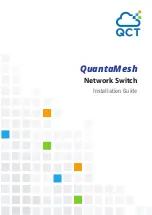
C613-50102-01 REV C
Command Reference for x510 Series
494
AlliedWare Plus™ Operating System - Version 5.4.6-1.x
VLAN C
OMMANDS
PORT
-
VLAN
-
FORWARDING
-
PRIORITY
port-vlan-forwarding-priority
Overview
Use this command to specify which protocol has the highest priority for controling
transitions from blocking to forwarding traffic. This command prioritizes switch
port forwarding mode control, when more than one of EPSR, Loop Protection, and
MAC thrashing protection protocols are used on the switch.
EPSR, Loop Protection and MAC Thrashing use the same mechanism to block or
forward traffic. This command specifies either EPSR or Loop Protection as the
highest priority protocol. Setting the priority stops contention between protocols.
For more information, see the Usage section below.
CAUTION
:
The
loop-protection
and
none
parameter options must not be set on an
EPSR master node. Use the epsr parameter option on an EPSR master node instead.
Setting this command incorrectly on an EPSR master node could cause unexpected
broadcast storms
.
Use the
no
variant of this command to restore the default highest priority protocol
back to the default of EPSR.
For more information about EPSR, see the
Syntax
port-vlan-forwarding-priority {epsr|loop-protection|none}
no port-vlan-forwarding-priority
Default
By default, the highest priority protocol is EPSR
Mode
Global Configuration
Usage
Only one of EPSR, Loop Protection and MAC Thrashing protection usually needs to
be configured on a switch, because they perform similar functions—each prevents
network loops by blocking a selected port for each (loop-containing) VLAN.
Parameter
Description
epsr
Sets EPSR as the highest priority protocol. Use this parameter on
an EPSR master node to avoid unexpected broadcast storms.
loop-
protection
Sets Loop Protection as the highest priority protocol.
Note that this option must not be set on an EPSR master node.
Use the epsr parameter option on an EPSR master node to avoid
unexpected broadcast storms.
none
Sets the protocols to have equal priority. This was the previous
behavior before this command was added, and allows protocols
to override each other to set a port to forwarding a VLAN.
Note that this option must not be set on a EPSR master node.
Use the epsr parameter option on an EPSR master node to avoid
unexpected broadcast storms.
















































